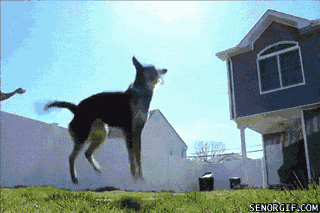
Chesapeake Bay Retrievers are so cool so why don't you have a look at some facts about them!
#1. "The Chesapeake Bay Retriever is a powerful, muscular dog."
#2. "The head is broad."
#3. "The wide-set eyes are yellowish to amber in color."
#4. "The small ears are high set hanging loosely."
#5. "The teeth meet in a scissors or level bite."
#6. "The lips are thin."
#7. "The tail is medium in length, heavy at the base."
#8. "The feet have webbed toes to aid in swimming."
#9. "The oily, short coat is dense with a wave. The oils in the coat not only repel the water like a ducks feathers do, but it helps the dog dry quickly, enabling the dog to swim in colder waters. Coat colors include brown, red, sedge or tan the shade of dead grass. Sometimes there is a small white spot on the breast, belly, toes, or back of the feet."
#10. "These are intelligent, brave and obedient dogs."
#11. "Trainable, willing and able to please, although they may be a little slow to learn."
#12. "Chesapeake Bay Retrievers are affectionate, loving, friendly and good with children."
#13. "They have a passion for water, swimming and retrieving."
#14. "This breed will get along with cats that are already living in your house, but may chase other cats."
#15. "The Chesapeake Bay Retriever is not recommended for an inexperienced new dog owner."
#16. "The handler needs to be confident, exerting a natural authority over the dog."
#17. "A firm, consistent but kind approach is the most successful way to handle them."
#18. "If possible, attend obedience classes with this breed."
#19. 'Proper canine to human communication is essential."
#20. "Be sure to properly train and socialized them."
#21. "Take your puppy out with you as much as possible and introduce it to other dogs so that it has a chance to feel relaxed with them."
#22. "The Chesapeake tends to be more dominant than other retrievers."
#23. "Without the proper leadership they can become territorial, aggressive, willful, reserved with strangers and may not get along with other dogs."
#24. "Chessies are strong canines that require firm training and good management."
#25. "Chesapeakes are usually slow to mature."
#26. "With the right owners they are a joy to own."
#27. "Height: Dogs 23-26 inches (58-66 cm.)
Bitches 21-24 inches (53-61 cm.)"
#28. "Weight: Dogs 65-80 pounds (29-36 kg.)
Bitches 55-70 pounds (25-32 kg.)"
#29. "Prone to eye problems and hip dysplasia."
#30. "Chesapeake Bay Retrievers are not recommended for apartment life. They are relatively inactive indoors and will do best with at least an average-sized yard. Chesapeake Bay Retrievers often enjoys sleeping outdoors if it is cooler outside, as they prefer cool climate."
#31. "The Chesapeake Bay Retriever needs a good deal of vigorous activity, including swimming if possible. If they do not get enough exercise they may become badly behaved from boredom and bottled up energy. They need to be taken on a daily brisk, long walk or jog where the dog is made to heel. They should never be allowed to walk out in front of the person holding the lead, as in a dog's mind, the leader leads the way and that leader needs to be the humans."
#32. "Life Expectancy: About 10-12 years."
#33. "The dense, harsh, short-haired coat is oily with a distinct smell and is easy to groom. Brush with a firm bristle brush to remove the dead hairs. While the Chesapeake needs the occasional bath to prevent any noticeable odor, they should not be bathed so often that the oily texture is stripped out. The oily coat helps protect the dog from icy waters. This breed is an average shedder."
#34. "In the winter of 1807, an English ship with two Newfoundlands on board wrecked off the coast of Maryland. Everyone was saved, and the two dogs were given to a family of dog lovers. They were later mated with local retrievers including English Otter Hounds, Flat-Coated Retrievers and Curly-Coated Retrievers. Careful breeding over the years has created an outstanding retriever with incredible enthusiasm and endurance. The dogs were used to hunt waterfowl in rough and icy waters of the Chesapeake Bay. The Chesapeake Bay Retriever has been known to retrieve hundreds of birds in a single day in frigid waters. This lively, enthusiastic hunter will come out of a river or marsh with only a few drops of water remaining on its oily coat, and these are quickly eliminated with a shake. Water rolls off the dog like a duck. Some of the Chesapeake Bay Retriever's talents include: tracking, hunting, retrieving, guarding, watchdog, schutzhund, field spots and competitive obedience. The Chesapeake Bay Retriever was recognized by the AKC in 1878."
Info from: http://www.dogbreedinfo.com/chesapeakebay.htm
Pic from: http://www.justdogbreeds.com/chesapeake-bay-retriever.html




No comments:
Post a Comment